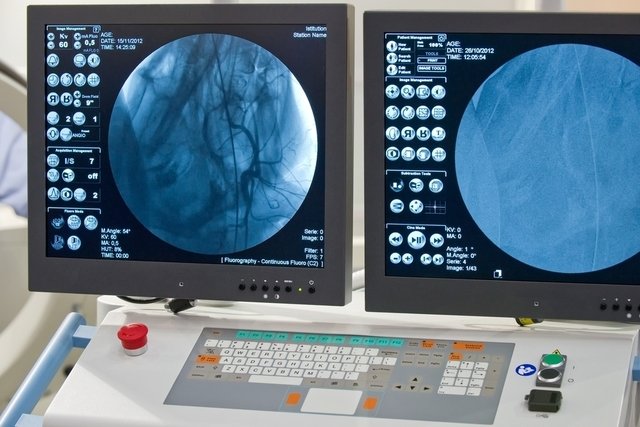Myelography is an exam that evaluates the spinal cord, being indicated to investigate or diagnose the cause of symptoms such as tingling or weakness in the arms or legs, or to evaluate the progression of some diseases, such as herniated discs, or injuries to the spinal cord nerves. , for example.
This examination is carried out by applying a radiological contrast inside the spinal canal, and performing a real-time x-ray, called fluoroscopy, or computed tomography, which allows the evaluation of the blood vessels, nerves and other structures of the spinal canal.
Myelography is carried out by a radiologist and can be carried out free of charge by the SUS, as long as there is a medical indication, but it is also carried out in hospitals or private examination clinics.

What is it for
Myelography is indicated for:
- Disc herniation;
- Injuries to the nerves in the spinal cord;
- Inflammation of the nerves covering the spinal cord;
- Spinal stenosis, which is the narrowing of the spinal canal;
- Brain tumor or cysts;
- Ankylosing spondylitis.
Furthermore, myelography may be recommended by the doctor to investigate the occurrence of infections that may be affecting the spinal cord or help identify the cause of symptoms such as tingling, weakness in the arms or legs or back pain, for example. Check out the main causes of back pain.
Typically, myelography is indicated when conventional X-rays are not sufficient for diagnosis or to assess the evolution of the health condition.
Myelography must be carried out with the recommendation of a neurologist, orthopedist, oncologist or rheumatologist, for example, and carried out by a radiologist.
Make an appointment with a neurologist in the nearest region:
Taking care of your health has never been easier!
How to prepare for myelography
To prepare for myelography, it is recommended to drink plenty of fluids in the two days before the exam and fast for about 3 hours before the exam.
Furthermore, it is important to inform the doctor if you are allergic to contrast or anesthesia, if you have a history of seizures, if you use anticoagulants or if there is a chance of pregnancy, in addition to recommending the removal of piercings and jewelry.
How it is made
Myelography is performed by a radiologist in a hospital or examination clinic by applying radiological contrast to the spinal canal and performing a fluoroscopy or computed tomography scan.
To perform myelography, the doctor must follow some steps, such as:
- Lay the person down on an examination table;
- Perform skin asepsis on the back so that anesthesia and radiological contrast can be applied;
- Apply an anesthetic to the lower back with a fine needle;
- Insert an intrathecal needle into the subarachnoid space of the spinal canal and remove a small amount of spinal fluid to evaluate in the laboratory;
- Apply radiological contrast to the spinal canal through the spinal needle, and the person may feel slight pressure in the head at that moment;
- Take a real-time x-ray, called fluoroscopy, or computed tomographywith the aim of evaluating how the contrast passes through the spinal canal and reaches the nerves correctly;
- Remove the needle from the spinal canal at the end of the examination and place a bandage on the area.
Myelography allows the doctor to observe any change in the pattern of contrast spread, which is why it is useful in diagnosing or evaluating the progression of the disease.
Care after the exam
After the exam, it is recommended that the person stays in the hospital for 2 to 3 hours to recover from the local anesthesia, in addition to being recommended to drink plenty of fluids to promote the elimination of the contrast.
Furthermore, it is recommended to rest for approximately 24 hours after the exam and avoid intense activities.
Possible side effects
The side effects of myelography are usually related to the contrast, and some people may experience a headache, back or leg pain, however, these changes are considered normal and disappear after a few days.
However, when the pain does not go away after 24 hours or when it is accompanied by fever, nausea, vomiting or difficulty urinating, it is important to report these changes to your doctor.
Who shouldn’t do
Myelography should not be performed on women with suspected or confirmed pregnancy due to exposure to radiation.
Bibliography
- PRICE, D. B.; ORTIZ, A. O. Myelography: From Lipid-Based to Gadolinium-Based Contrast Agents. . . . Magn Reson Imaging Clin N Am. 25. 4; 713–724,
- POMERANTZ, S. R. Myelography: modern technique and indications. Handb Clin Neurol. 135. 193-208, 2016
- LUTTERS, B.; et al. Myelography and the 20th Century Localization of Spinal Cord Lesions. Eur Neurol. 83. 4; 447-452, 2020
- INSTITUTE OF DIAGNOSTIC AND INTERVENTIONAL RADIOLOGY. Myelography. Available at: <https://www.spital-oberengadin.ch/fileadmin/user_upload/spital/dokumente/pdf/Landingpages/PT/05_Paediatrische_Radiologie/MIELOGRAFIA_FOLHA_DE_INFORMACAO.pdf>. Accessed on 23 Sep 2020
- RAMOS, Barbara C.; MANZI, Flávio Ricardo; VESPASIANO, Amaro I. Myelography and residual contrast in panoramic radiography: case report. RGO, Rev Gaúch Odontol. 2019;

Sign up for our newsletter and stay up to date with exclusive news
that can transform your routine!
Warning: Undefined array key "title" in /home/storelat/public_html/wp-content/plugins/link-whisper-premium/templates/frontend/related-posts.php on line 12
Warning: Undefined array key "title_tag" in /home/storelat/public_html/wp-content/plugins/link-whisper-premium/templates/frontend/related-posts.php on line 13



